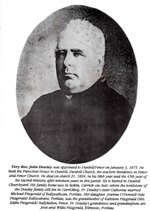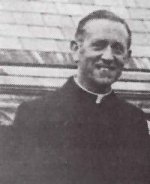Fenor 1884 – 1984
Some Traditions and Folklore of our Parish
by Rita Byrne.
What was life like for the people who built our church?
The Fenor of 1894 was very different from the Fenor of today. It is difficult to visualise houses without running water or electricity, no TV in the living room, and no car outside the door. The lives of our grandparents were hard by comparison with ours and were still dominated by the old ways. Practices and customs that had been handed down from their forefathers were faithfully adhered to. There was a time and a way to do all things and there were spirits to be respected and deferred to.
Our grandparents had tremendous faith in God and in the saints but they also respected the power of the fairies and the spirit world. For centuries these traditions, customs, beliefs, and cures remained alive. Now, with the coming of the age of technology, they have virtually disappeared. Much of what is here will, no doubt, be dismissed as piseóga or superstition. However, for some, they are a never-ending source of delight and curiosity.
From birth to death and in between
The coming of a baby into a family was a great and happy event. The time of birth was important. Babies came, usually, with the phase of the moon and, if a baby was overdue, the old people would be out watching the moon to see how close to the full moon or new moon it was. May Day was a very lucky day on which to give birth, but Whitsun was deemed to be the most unlucky time. Before birth it was possible to predict the baby’s sex by swinging a string, which was threaded through a needle and stuck into a cork like a pendulum, over the tummy of the expectant mother – right to left for a boy, and in a circle for a girl. “Tá sé ag teacht abhaile” was a way of letting adults know that somebody was pregnant while shielding the fact from children. Babies were sometimes lazy and took their time in coming. A full bottle of castor oil taken fasting by the mother was sure to do the trick and bring on the birth. Most babies were delivered by the local handy woman or midwife but Tramore and the area surrounding were served by a trained midwife. There were precautions taken even before birth to preserve the mother and baby and keep them free from harm and safe from the evil eye.
Should the unfortunate woman meet a hare, her baby would surely be born with a harelip. Of course this could be prevented simply by the turning up of her skirt and putting a tear in her petticoat. Men who hunted the hare always cut off the scut (tail) immediately after killing the animal for fear of the damage that it would do if it met an expectant mother. It was also considered very bad form and very dangerous for a pregnant woman to attend a funeral, since there was the fear that the baby would be born dead or deformed. Club foot was caused by the mother slipping or stumbling in the graveyard and I was told of one lady who was foolish and who went to a funeral when heavily pregnant. She leaned against a headstone and, when her baby was born, it had a birthmark in the shape of a headstone on its back. “And that’s as true as God”.
The Saddest of All Customs
The saddest of all customs were those that dealt with the death of babies and young children. Unbaptised babies could not be buried in consecrated ground so they were buried between sunset and sunrise outside the walls of the graveyard or in a disused graveyard, a cillín, or a ring fort. The souls of the little babies had to carry a lighted candle forever. Those baby-lights were often seen at night outside graveyards, especially in the month of November. People believed that the lonely little souls were searching for their parents or relations inside the graveyard.
Up to fifty years ago, unbaptised babies in Fenor were buried in the path around the graveyard. Parents did not go to the grave with the dead child, particularly if it was their first child, believing that, if they brought one child to the grave, they would bring the next and possibly all of their children there also. Should more than two infants from the same family be born dead, the cycle could be broken by changing the place in which the infants were buried.
Babies born with a caul were blessed with a great talent or gift. A caul is a membranous tissue which covers the head and neck. This caul was always preserved by the child’s mother and sailors valued it above all other things, believing that, if they had a caul on board ship, they would never be drowned.
Babies and Fairies
The evil eye, the fairies and the púicín had the life scared in most people and parents were especially vigilant. A piece of silver was placed in the cradle to preserve the baby from evil and salt was rubbed on the forehead. Neighbours and friends, on first seeing the baby, would place a silver coin in its hand or shawl. Under no circumstances could the baby’s nails be cut until after the first birthday since, if the nails were cut, the child would grow up to be a thief. Instead, the nails were bitten off by the parent and placed in the bottom of the cradle.
Baby boys, of course, were in greater danger than baby girls because the fairies were always on the lookout for little boys, so great care had to be taken to keep them safe. Young boys were dressed in petticoats until they were six or seven years old to fool the fairies. Despite this they sometimes succeeded in switching babies and, instead of a beautiful happy thriving child, a “sheevra” [siaḃra] was left. This sheevra was a cross, contrary little fellow who would fail to thrive. He was sometimes called an “auaichin” [aḃacín]. Baby girls were sometimes marked by fairies also. Late in the last century, a woman in the parish who was thinning turnips, left a baby girl wrapped in a shawl on the headland of the field. She heard the baby scream and ran to see what was wrong. One of the child’s legs had withered, and stuck out at an angle. She remained like that until the day she died. The place where she had been left was a fairy pass – or so it was generally believed.
Cures
Children who survived the rigours of childbirth had then to face childhood illnesses – without the medical services and antibiotics that are available to us today. Scalds were treated with the first snow of the year. The snow water was melted and kept. Burns were treated with bread soda or linseed oil, or country butter and egg yolk made into a paste. A badly burned or scalded child was plunged into the churn of buttermilk and, of course, there was always the dog’s lick, which had great curative powers.
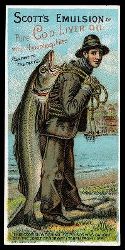
Cod-liver oil and Scott’s Emulsion were taken by children to build up their strength and prevent cold and childhood illnesses. Adults took raw eggs beaten up with warm milk and a drop of whiskey, or a glass of mulled stout with sugar was almost as good. Vick was used on the chest and a spoon of honey soothed a chesty cough. For pneumonia, a poultice of candle wax on brown paper was wrapped around the body. People who suffered from backache always carried a small potato in their pocket and Our Lady’s flower was carried in the pocket to prevent stroke. This little blue flower grows commonly in the month of May. Of course, red flannel worn across the back, was especially good for low back pain. This flannel should be washed. Pepper, especially Cayenne pepper, taken fasting, mixed with a drop of water and followed by a big glass of milk or water, was a marvellous cure for arthritis, rheumatism, lumbago or sciatica.
Most of us have spent a sleepless night or two counting the hours until dawn. The cure for insomnia is very simple – onions boiled in milk, sprinkled with pepper, and taken as a bedtime drink. This was also very good for the kidneys. Hives were common in children, probably because of deficiency in the diet, so boiled nettles were eaten in March to clear the blood. Slouchán was boiled in March, too, and given to children for worms. This dose was repeated after eight days. Three drinks of barnacle water in March kept a child free from worms for the year, and “yalla male” (yellow meal) stir-about cleared a child of tape worms.
Whooping Cough
 Many of us remember the horror of whooping cough for which there was no medical cure, but of folk cures there were many – most of them hair-raising. A live frog put into the child’s mouth when fasting should cure the whooping.
Many of us remember the horror of whooping cough for which there was no medical cure, but of folk cures there were many – most of them hair-raising. A live frog put into the child’s mouth when fasting should cure the whooping.
The usual cure was to ask a man riding a white horse for his cure, which was usually to pass the child over and under the horse three times. Ferrets’ leavings were given to the patient as a good cure. A plate of bread and milk was given to the ferrets and whatever was left was fed to the patients. Paddy Power has an Irish cure which goes like this: “Bhí fear ag marcaíocht go dtí an margadh i nDún Ghearbhán agus ag an droichead in nDún na Mainistreach bhí seanbhean ina suí agus d’iarr sí air., ‘A fhear a chapall bháin, cad é an leigheas ar an triuc?’ D’fhreagair sé í, ‘A Dhún Ghearbhán beirig an “whey” (boiled whey). Sin é an leigheas ar an triuc?'” (Whooping cough was also called pioc or chin-cough).
A stocking filled with warm salt was put around a sore throat, and salt and water was gargled. I got a cure for jaundice from an elderly neighbour twenty-five years ago which really works. The blossom of the furze was boiled with vinegar, beer, brown sugar, and saffron. This was taken, about a wineglass per day, for nine days. Another good cure, which is still in use, is the inner bark of the barberry, infused with porter and brown sugar, and taken three times. These cures work on dogs as well as humans.
The common cure for headache and also for throat ailments was the Brat Bríde or the St. Brigid’s ribbon. The ribbon, which was left outside on the eve of St. Brigid’s Day, was blessed by the saint. The ribbon was put around the head or throat of the patient. The brat or ribbon was also put across the cow’s back when calving or if she was sick. On St. Brigid’s eve men also put out their braces or galluses so that the saint would bless them also. This blessing gave the men strength to do their daily work for the whole year. It was believed that thin, skinny children got over measles more easily than fat children and that any ailment that came with measles stayed with the person for life. Deafness and sore eyes and often blindness or partial blindness resulted from measles, so the patient was kept in darkness to protect the eyes. Sore eyes were treated with cold tea or by twisting a gold wedding ring around the eye nine times, and the thorn of the gooseberry bush was used to let out the puss in a stye. The blessed well of St. Declan was the place to go on pilgrimage for people who feared blindness and many people went on horseback or by pony and trap to Ardmore to wash in the water and do the rounds.
Leg ulcers, which were a common complaint in the elderly, especially in women, were treated with a bandage of green cabbage or slánlus (or slanns). Skin cancer was treated with pennyleaf or dock leaf and so were nettle stings. Bee stings were rubbed with the blue bag and wasp stings were cured by rubbing a raw onion on the affected area.
The Blacksmith Doctor
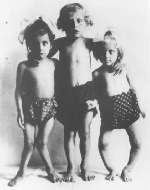 Water from the forge had magical cures and was used to cure itch, chilblains, eczema, to remove warts, and to get rid of freckles. The blacksmith could diagnose and cure most of the ailments of animals, especially horses. Tom Power (RIP), who was the local blacksmith and was the seventh generation of blacksmiths of that name, could cure rickets.
Water from the forge had magical cures and was used to cure itch, chilblains, eczema, to remove warts, and to get rid of freckles. The blacksmith could diagnose and cure most of the ailments of animals, especially horses. Tom Power (RIP), who was the local blacksmith and was the seventh generation of blacksmiths of that name, could cure rickets.
Rickets caused deformed limbs in children and was common early this century. The blacksmith made the sign of the cross on the thumbnail of the child with a piece of iron over the anvil. He said a prayer also – perhaps the Ár nAthair.
People who have suffered from shingles tell me that it is a very painful ailment, sore and difficult to cure. There is a charm to cure shingles which works and the shingles clear up within a few days. The person with the charm pricks the finger and makes a circle of blood around the affected area. This is repeated three times. Cahills and Caulfields have the cure for shingles, so the cure is known as Cahill’s blood or Caulfield’s blood. Seventh sons have the cure for ringworms and they are also blessed with the ability to set bones and cure sprains. When a seventh son or, better still, the seventh son of a seventh son was born, a worm was put into its hand and, if the worm curled up and died, the child had the charm. In the last century, when football and hurling matches went on from after second Mass to the onset of darkness, the bonesetter was as important as today’s casualty unit in Ardkeen. Goose grease was always preserved in a jam jar for the treatment of sprains in humans and animals. Geese were killed at Christmas for St. Martin – turkeys did not take on until the 1930s.
Warts and Bleeding
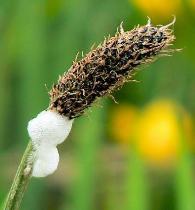 Warts must have been a very common complaint in days gone by because everybody in the parish has a treatment which works. People believed that warts on the hands were caused by washing the hands in water in which eggs were boiled. A fasting spit rubbed on the wart or the froth from the cuckoo’s spit, or water from the forge, all worked a treat. There is a wart well in Drumcannon below Tramore and there was a stone in the orchard of Power’s, Islandtarsnay (the Tailors). This stone had a depression in it where rainwater collected. You just washed the affected part in this water and, appropriately, it was called the wart stone. The dew of the grass before sunrise on May morning removed warts as well as corns, bunions, freckles, and all skin blemishes, and guaranteed eternal beauty.
Warts must have been a very common complaint in days gone by because everybody in the parish has a treatment which works. People believed that warts on the hands were caused by washing the hands in water in which eggs were boiled. A fasting spit rubbed on the wart or the froth from the cuckoo’s spit, or water from the forge, all worked a treat. There is a wart well in Drumcannon below Tramore and there was a stone in the orchard of Power’s, Islandtarsnay (the Tailors). This stone had a depression in it where rainwater collected. You just washed the affected part in this water and, appropriately, it was called the wart stone. The dew of the grass before sunrise on May morning removed warts as well as corns, bunions, freckles, and all skin blemishes, and guaranteed eternal beauty.
Stranger still are the following cures. If the wart is rubbed with a piece of fat-bacon and the bacon is then buried, the wart disappears as the bacon rots away. A raw potato rubbed on and then thrown away works the same way. A very common cure is the shellakiepookie cure. You get a shellakiepookie (snail), rub the wart with him, stick him on a thorn and, as he withers away, the wart disappeares. Caustic soda and wart plant (spunk) were rubbed on the wart.
There were two people from the parish who had the charm to cure warts. They used a straw from the rick and made the sign of the cross on the wart, then they buried the straw and the wart just disappeared within a few days. If all of these failed, a hair from the horse’s tail was tied tightly around the wart until it withered. Take your pick, they all work if you have faith.
To Stop Bleeding
The charm to stop bleeding was most peculiar because it worked on animals as well as people and it worked at a distance.
William Kiely from Killfarrasy had the charm. A mare of Bob Phelan’s jumped a gate and burst a vein in her leg when she hit the top rail. The workman ran for William. He had a prayer that he used to say to stop the bleeding. The workman urged him to come quickly but he answered, “I said the prayer, it will be stopped when I get there” – and it was.

The charm to stop bleeding was passed from a man to a woman to a man and could not be used unless someone requested it. (I was privileged to be given the prayer to stop bleeding by Tommy Drohan, who got it from his grandmother.) St. Martin’s blood was also used to clear bleeding. On St. Martin’s eve (November 10th) a cock or some domestic animal was killed and the blood was sprinkled on the door-post and also on a cloth. This cloth was kept safely and applied to any bleeding wound.
For every ailment there was a folk-cure – an eelskin for tralach [tráileaċ], or cork under the matress for cramps in the legs, boiling potato-water for hangnail, oatmeal water for freckles, a cobweb or a key down the back of the neck for nosebleed. Many of the old cures are lost and very few of them are used. Nowadays, however, there are still people to whom we turn in times of specific need – the healers and the people with “the cure” .



 The charm to stop bleeding was most peculiar because it worked on animals as well as people and it worked at a distance.
The charm to stop bleeding was most peculiar because it worked on animals as well as people and it worked at a distance.



